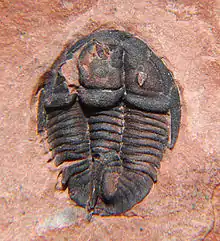| Genevievella Temporal range: | |
|---|---|
 | |
| Genevievella granulosa, 18mm | |
| Scientific classification | |
| Kingdom: | |
| Phylum: | |
| Class: | |
| Order: | |
| Superfamily: | |
| Family: | Llanoaspididae |
| Genus: | Genevievella Lochman, 1936 |
| Type species | |
| Genevievella neunia Lochman, 1936 | |
| Synonyms[1] | |
|
Placosema Opik 1967 | |
Genevievella is a genus of trilobites with a short inverted egg-shaped outline, a wide headshield, small eyes, and long genal spines. The backrim of the headshield is inflated and overhangs the first of the 9 thorax segments. The 8th thorax segment from the front bears a backward directed spine that reaches beyond the back end of the exoskeleton. It has an almost oval tailshield with 5 pairs of pleural furrows. It lived during the Upper Cambrian in what are today Canada and the United States.[2]
Distribution
- G. caelata is known from the Upper Cambrian of Australia (Mindyallan, Upper beds Member, Mungerbar Formation, Glenormiston, Queensland, 22.9° S, 138.8° E).[3]
- G. simon, G. cuniculaena, G. raggedi and G. campbellina have been found in the Upper Cambrian of Canada (Dresbachian, Rabbitkettle Formation, Yukon, 62.7° N, 128.4° W).[4]
- G. campbellina occurs in the Upper Cambrian of the United States (Merioneth: Warriorsmark, Huntingdon, Huntingdon; Warrior Formation, near Waddle, Centre County, all Pennsylvania, 40.8° N, 77.9° W)[5]
- G. spinox has been excavated from the Upper Cambrian of the United States (Dresbachian, Coosella zone, Riley Formation, Central Texas, 30.3° N, 97.7° W)[6]
- G. bigranulosa is present in the Upper Cambrian of China (Guzhangian, Glyptagnostus stolidotus trilobite zone and Paibian, Glyptagnostus reticulatus trilobite zone, both Huaqiao Formation, Hunan, 28.4° N, 109.5° E).[7]
References
- ↑ "†Genevievella Lochmann 1936". Paleobiology Database. Fossilworks. Retrieved 17 December 2021.
- ↑ Moore, R.C. (1959). Arthropoda I - Arthropoda General Features, Proarthropoda, Euarthropoda General Features, Trilobitomorpha. Treatise on Invertebrate Paleontology. Vol. Part O. Boulder, Colorado/Lawrence, Kansas: Geological Society of America/University of Kansas Press. pp. O301. ISBN 0-8137-3015-5.
- ↑ Pojeta, J.; Gilbert-Tomlinson, J.; Shergold, J.H. (1977). "Cambrian and Ordovician rostroconch molluscs from Northern Australia". Australian Bureau of Mineral Resources, Geology and Geophysics Bulletin. 171: 1–54. cited in Pete Wagner. "Locality 50. G127*. Glenormiston". Fossilworks. Retrieved 17 December 2021.
- ↑ Pratt, B.R. (1992). "Trilobites of the Marjuman and Steptoean stages (Upper Cambrian), Rabbitkettle Formation, southern Mackenzie Mountains, northwest Canada". Palaeontographica Canadiana (9): 1–109. cited in Shanan Peters. "Section N - collection N-33". Fossilworks. Retrieved 17 December 2021.
- ↑ Tasch, P. (1951). "Fauna and paleoecology of the Upper Cambrian Warrior Formation of central Pennsylvania". Journal of Paleontology. 25 (3): 275–306. cited in Uta Merkel. "Highway No. 322 near Waddle, Bed 11.12". Fossilworks. Retrieved 17 December 2021.
- ↑ Sepkoski Jr., J.J. (1998). "Rates of speciation in the fossil record". Philosophical Transactions of the Royal Society of London B: Biological Sciences. 353 (1366): 315–326. doi:10.1098/rstb.1998.0212. PMC 1692211. PMID 11541734. cited in Mike Sommers. "Central Texas, Riley Fm., Texas". Fossilworks. Retrieved 17 December 2021.
- ↑ Peng, S.; Robison, R.A. (2000). "Agnostid biostratigraphy across the Middle-Upper Cambrian boundary in Hunan, China". Journal of Paleontology Memoir. 53. cited in Austin Hendy. "Paibi section, bed 37a". Fossilworks. Retrieved 17 December 2021.
This article is issued from Wikipedia. The text is licensed under Creative Commons - Attribution - Sharealike. Additional terms may apply for the media files.